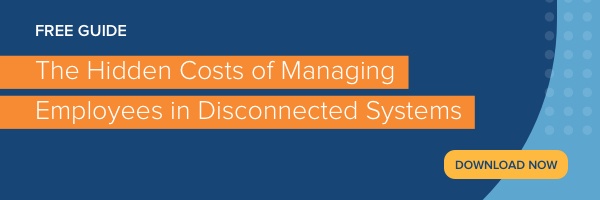Your payroll provider is responsible for helping you deliver accurate employee pay, but if the provider falls short of expectations, you may need to make a switch. Changing payroll providers is no small thing, but you can manage a seamless transition with a solid plan and a provider that delivers comprehensive payroll tools and services.
Why Switch Payroll Providers?
There are many reasons why you might need to change payroll providers. Perhaps you have experienced the following problems with your current provider:
- Erroneous employee paychecks or tax statements
- Outdated payroll systems
- Spotty or unresponsive customer service
- A lack of services to help you improve your payroll processes
If you’ve experienced any of these issues and have grown dissatisfied with your current provider, you’re not alone. The EY Global Payroll Survey Report found that only 14 percent of respondents rated their current payroll provider as very good at accuracy in payroll, and only 2 percent rated their provider as very good in problem resolution.
Any change in payroll systems or providers must occur with as little disruption to your workforce as possible. When you need to switch payroll providers, you can use these ideas to get started.
Avoid the Common Pitfalls of Switching Payroll Providers
Switching payroll providers isn’t a decision you make lightly. After all, any change you implement carries over into other areas, such as benefits, taxes, and the overall employee experience. Errors or inaccuracies caused by a change in payroll providers can be highly frustrating for employees, especially because nearly 80 percent of U.S. workers live paycheck to paycheck, according to a CareerBuilder study,
Some of the pitfalls you’ll want to avoid when switching providers include:
Changing Payroll Providers in a Vacuum
Payroll actions go hand in hand with other aspects of workforce management, such as benefits and time and attendance. If you change providers without making changes in other areas, payroll changes in one system can easily fall out of sync with HR data in other systems. One way to achieve seamless updates across multiple areas is to use an all-in-one human capital management (HCM) system. When your HR programs and activities are managed together on one platform, any changes you make to payroll will automatically be reflected in other areas.
Switching to a Provider that Doesn’t Use the Cloud
A provider that uses a desktop system or a series of digital downloads leaves you without the benefits of a cloud-based system, such as 24/7 anywhere access, automatic system upgrades, and employee self-service.
Moving to a Stand-Alone Payroll Provider
An independent payroll company typically focuses on payroll alone. At best, such a provider can only offer integrations with a few of the systems you may already be using. In contrast, an integrated payroll system is designed to work in concert with benefits, time and attendance, and other facets of workforce management.
Insufficient Onboarding and Ongoing Support
If you switch to a provider that expects you to do all of the initial data entry and doesn’t help with the initial setup, the switch could cost you more time than it saves. When you don’t get enough help to get payroll services up and running, you’re more likely to experience errors. A lack of ongoing support only makes things worse.
How to Switch Payroll Providers in 7 Steps
To avoid the common pitfalls of switching payroll providers, follow these steps:
Step 1. Review your contract with your existing payroll provider. Make sure you understand the cancellation policy and any related deadlines before you cancel.
Step 2. Pick a good time to switch. An ideal time to switch providers is the beginning of the year or quarter. It reduces the possibility of errors and partial year or partial quarter reports.
Step 3. Make a checklist of the services and capabilities you require, and include any items you aren’t getting from your current provider. Services may fall into the following categories:
- Intuitive and easy-to-use cloud-based technology with dashboards and flexible reporting features
- Employee services such as self-service, direct deposit, and online pay stubs
- Integrations with other areas of workforce management
- Compliance with new and existing tax and pay laws
- Responsive customer service
- Additional services, such as 401k plan administration or time and attendance management
Step 4. Understand your new provider’s pricing. You don’t want to get stuck paying extra fees for services you consider essential. Without a clear understanding of all fees and fee structures, you could end up paying more for less.
Step 5. Prepare employee and company data. To set up your account and avoid errors, your new payroll provider will need the following information from you:
- Employee names, addresses, and social security numbers
- Current employee pay rates and deductions
- Contractor names, taxpayer IDs, and 1099 forms
- Completed direct deposit and W-4 forms
- Company federal and state tax IDs, payroll account details, and previous payroll tax returns
Step 6. Set a transfer date and notify employees. Explain new features, such as employee self-service, electronic pay stubs, and where to find important forms.
Step 7. After you’ve made the switch, check your new payroll records against the old ones for accuracy and completeness. It’s also a good idea to conduct regular payroll audits to understand the overall effectiveness of your new provider and payroll processes.
The Benefits of Switching
Once you know how to switch payroll providers and you choose the provider that meets your needs, you can expect a smoother payroll process for you and a better payroll experience for employees. Some of the specific benefits you can look forward to include:
- Greater efficiency: With a payroll system that does much of the work for you, you save time. More employee self-service access means you spend less time on requests for pay statements and basic payroll information.
- Fewer errors: Greater automation reduces errors associated with manual processes.
- More accurate reports: An integrated system helps you maintain data consistency across payroll, benefits, and time and attendance.
- Anywhere access: A cloud-based system gives you access to payroll records and reports from anywhere and any device.
- Better compliance: Regular updates from your provider keep you abreast of payroll best practices and new legislation affecting your payroll reporting, for example, the Paycheck Protection Program (PPP).
Integrate Your Payroll for Better Workforce Management
You can change payroll providers successfully when you have a solid plan and follow the necessary steps. To deliver workforce pay efficiently and accurately, consider an integrated payroll system. An all-in-one solution helps you manage payroll and all the other areas of talent management, so you can avoid the headaches of managing disparate HR systems.
Read our guide, The Hidden Costs of Managing Employees in Disconnected Systems, to learn more about the benefits of a fully integrated HR system.


